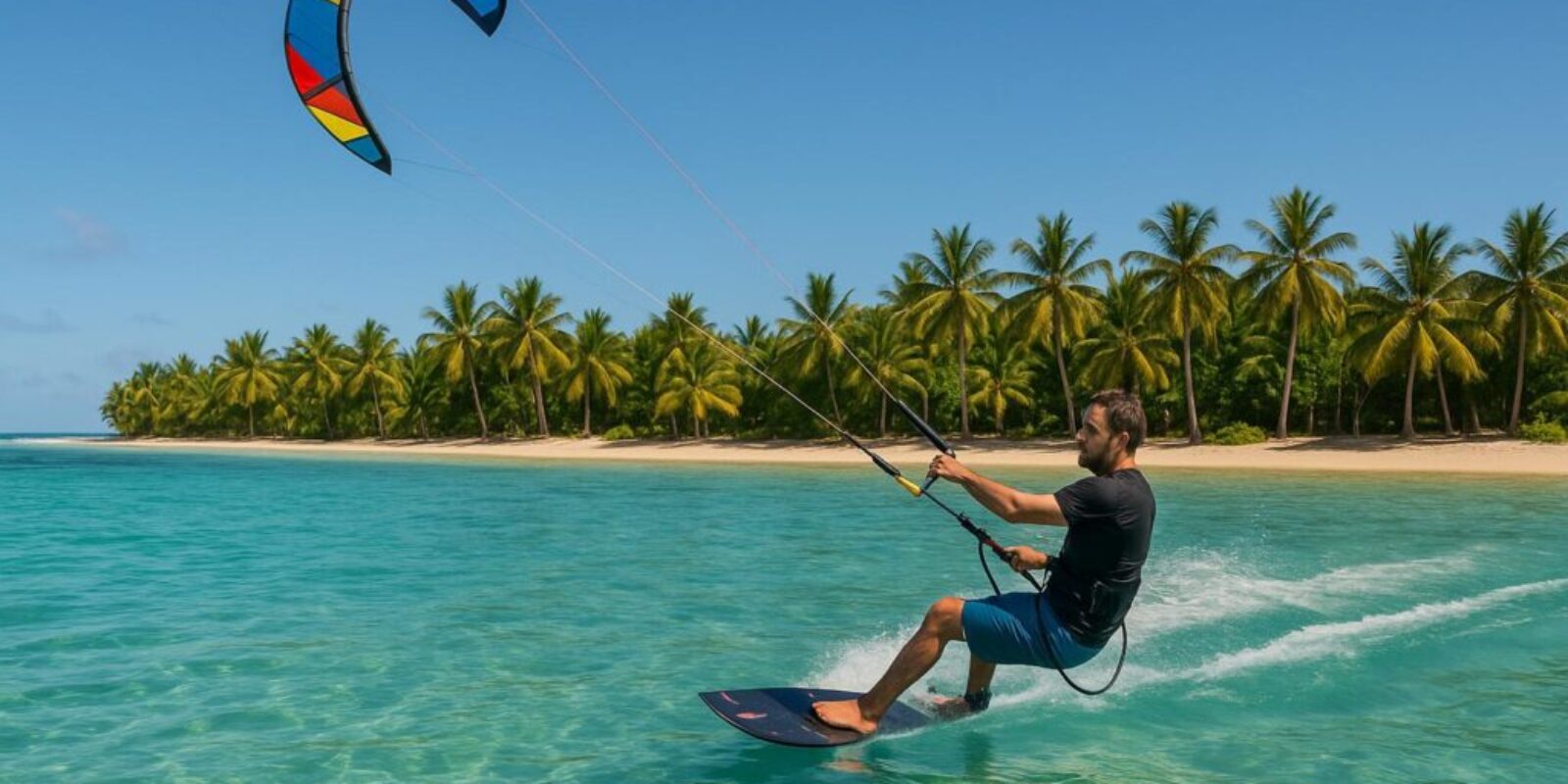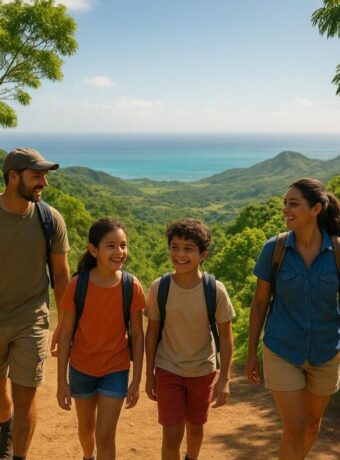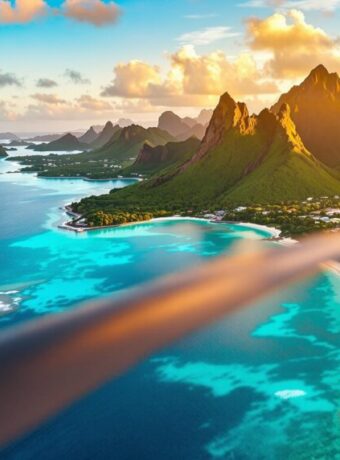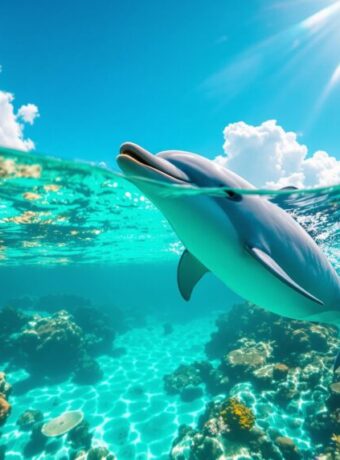Mauritius is a top destination for kitesurfing, offering ideal conditions for beginners and experienced riders alike. Here’s why:
- Perfect Conditions: Shallow lagoons, steady trade winds (15–25 knots from June to October), and warm temperatures (75°F air, 72°F water) make learning easier and enjoyable.
- Top Spots: Le Morne and Bel Ombre are beginner-friendly with calm lagoons, while advanced riders can enjoy reef waves.
- Affordable Lessons: Private lessons average $75/hour; group lessons are around $40/hour. Packages cater to all skill levels.
- Diverse Locations: Alternatives like Pointe d’Esny, Blue Bay, and Anse La Raie offer quieter settings and stunning waters.
With certified instructors, safety-focused schools, and flexible lesson packages, Mauritius combines learning with a tropical getaway. Whether you’re starting out or refining your skills, it’s an excellent choice for kitesurfing.
Kiteboarding lessons at Specialised Kiteboarding
How to Choose a Kitesurfing School
Picking the right kitesurfing school in Mauritius can make all the difference in your experience. With so many options spread across the island, focus on schools that emphasize safety, qualified instruction, and top-notch equipment.
What to Look for in a School
Start by ensuring the instructors are certified by recognized organizations like IKO or VDWS and have valid teaching licenses. These certifications, combined with hands-on experience, provide a safer and more effective learning environment .
Safety should always come first. Look for schools that provide thorough safety briefings, well-maintained gear, and clear emergency protocols. The best schools will offer modern kites, harnesses, and boards, along with properly fitted safety equipment – usually included in the lesson fee.
When it comes to lessons, private sessions cost around $75 per hour and offer personalized instruction, while group lessons, priced at about $40 per hour, can be more affordable but may provide less one-on-one time.
Finally, choose a school located in an area that offers ideal conditions for your skill level. The location can significantly impact your learning experience.
Best Areas to Find Schools
Le Morne is often considered the top spot for kitesurfing in Mauritius. This UNESCO World Heritage site features a protected lagoon and steady winds, making it perfect for beginners. In September 2024, Mauritius.com highlighted Le Morne Kite School as one of the island’s most trusted options, with over 11 years of experience and convenient hotel pick-up services. Its mix of shallow, calm waters for beginners and challenging reef breaks for advanced riders makes it a favorite for all skill levels.
Bel Ombre is another excellent location, offering similar conditions with a shallow lagoon and fewer crowds. If the eastern winds make Le Morne or Bel Ombre less ideal, Blue Bay and Pointe d’Esny are great alternatives. These spots feature crystal-clear water and access to Mauritius’s largest lagoon.
For those seeking a quieter atmosphere, head to Anse La Raie in the north. This area is known for its calm environment and is particularly well-suited for beginners. Keep in mind that popular locations like Le Morne can fill up quickly during the peak season (June to November), so proximity to your accommodation may also play a role in your decision.
Best Kitesurfing Spots for Beginners
Starting your kitesurfing journey requires the right mix of calm waters, steady winds, and safe surroundings. Mauritius is home to several beginner-friendly locations that check all these boxes, making it a fantastic destination for new riders. Here’s a look at the top spots where you can build skills and confidence.
Le Morne Lagoon
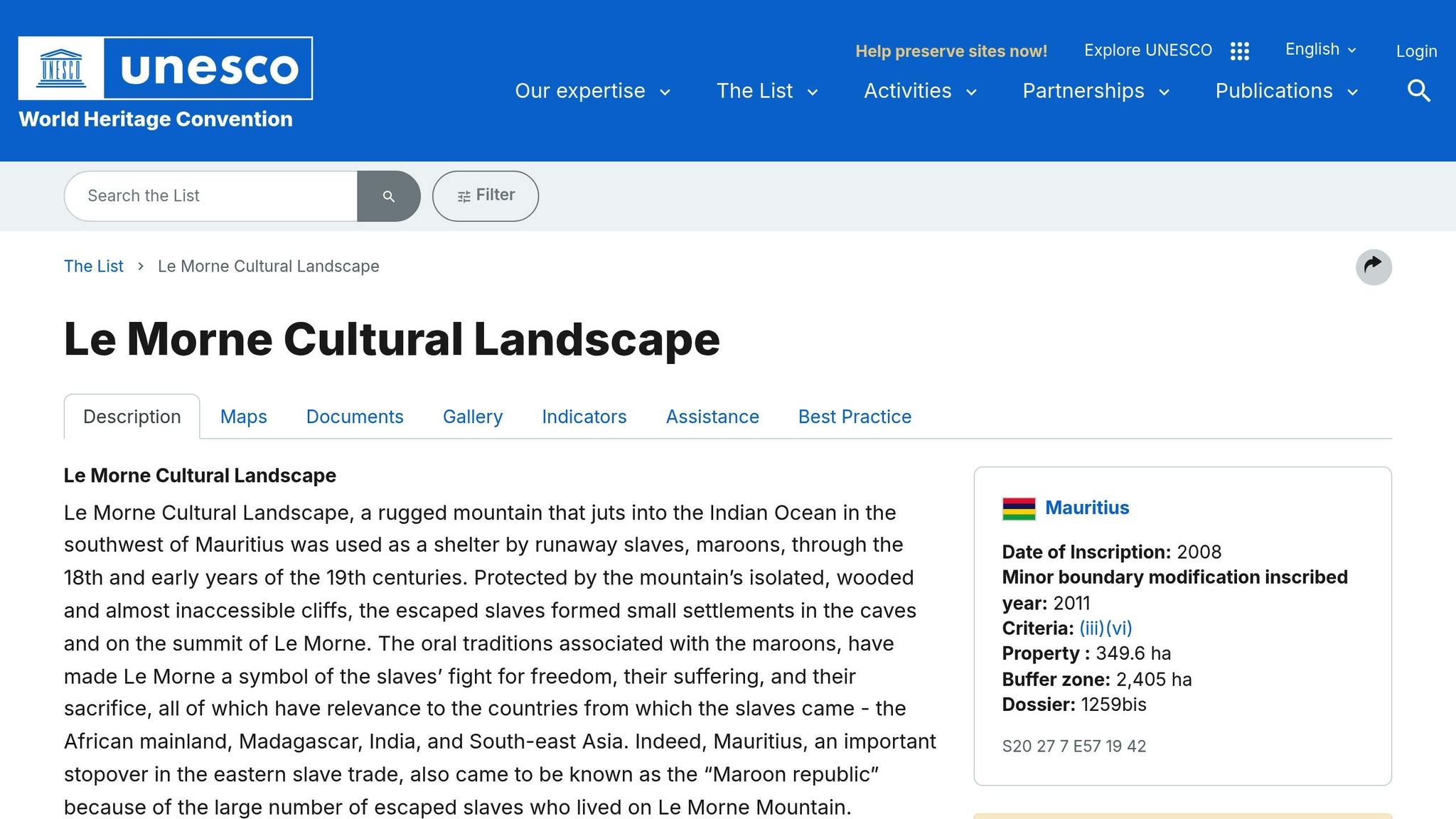
Le Morne Lagoon is a go-to spot for beginners, thanks to its calm, flat waters and sheltered setting. Here, you can focus on perfecting kite control and board techniques without worrying about battling rough waves. The wide, shallow lagoon offers plenty of space to practice, but wearing booties is a smart move to avoid injuries from coral or rocks. Plus, the area is dotted with kitesurfing schools that prioritize safety and provide high-quality training and equipment right on the beach.
Point d’Esny
If you’re after a more peaceful environment, Point d’Esny is a great option. Known for its crystal-clear waters and spacious lagoon, this spot offers a laid-back atmosphere perfect for learning. Many local schools here provide personalized instruction, often using boats to stay close to students during lessons. This added layer of support makes Point d’Esny particularly inviting for first-timers.
Wind and Water Conditions by Season
Choosing the right time to kitesurf in Mauritius is just as important as picking the right spot. The island’s wind and water conditions vary throughout the year, so timing your lessons wisely can make all the difference.
Peak Season (June to October) brings consistent winds ranging from 15 to 25 knots and water temperatures around 72°F (22°C). If you’re sensitive to cooler water, a long wetsuit might come in handy. > “The best time to kitesurf in Mauritius is undoubtedly from June to October”.
Mid-Season (April/May and October/November) offers warmer waters and gentler winds, making it ideal for beginners looking to improve their skills without dealing with large crowds.
Summer Season (November to April) features hotter, more humid conditions, but the winds can be less predictable, which might complicate lesson scheduling.
For beginners, mid-season months strike the perfect balance with manageable winds, warm temperatures, and fewer people on the water. However, if you’re planning a trip specifically for kitesurfing, the reliable trade winds of the peak season might be worth braving the cooler waters. Always check the local wind forecast before finalizing your plans!
What Happens During a Kitesurfing Lesson
Your first kitesurfing lesson is a mix of theory and hands-on practice, designed to help you build skills quickly and effectively. Here’s a breakdown of what you can expect to make the most of your time.
How Lessons Are Structured
Once you’ve picked your school, your lessons will follow a step-by-step approach that combines classroom knowledge with practical exercises. The theory portion covers essential topics like safety techniques, how to set up and pack down your gear, understanding wind and weather patterns, and learning to control the kite while on land.
When you move on to the practical side, you’ll start with a trainer kite, which helps you safely get the hang of basic kite control. Once you’re comfortable, you’ll head to the water for body-dragging exercises. These drills teach you how to relaunch the kite, steer effectively, and use the harness with confidence. The final stage is all about water starts and riding – learning how to get up on the board and ride in different directions. Throughout the process, your instructor will give you tailored feedback to help you improve.
This step-by-step method ensures you’re ready to explore the island’s diverse kitesurfing spots with confidence.
Gear and Preparation Tips
When it comes to kitesurfing, having the right gear and being well-prepared can make all the difference. While most schools provide the main equipment, like kites and boards, you’ll need to focus on bringing your personal essentials and getting yourself physically and mentally ready for the adventure.
What to Bring
Your kitesurfing school will typically supply the big items – kites, boards, and safety gear – but there are a few personal items you’ll want to have on hand. Start with swimwear that stays put during activity. For longer sessions, a long neoprene wetsuit (around 3/2mm) is usually a good choice, but if the weather’s warm and the wind is mild, a shorty wetsuit might do just fine.
From December to March, during the summer season, board shorts and a Lycra top are great options. Your wetsuit choice should always match the local water conditions for comfort and safety.
Neoprene shoes are a smart addition to protect your feet from sharp coral in lagoons. Other essentials include waterproof sunscreen, a rash vest or Lycra top, a cap, and polarized sunglasses to shield yourself from the sun.
It’s also a good idea to check with your school beforehand to see if they provide wetsuits. Some schools include them in their lesson packages, while others may offer them for rent. Beyond gear, being prepared also means getting your body and mind in the right place for the challenges ahead.
Getting Your Body and Mind Ready
Kitesurfing isn’t about brute strength – it’s all about technique. To prepare, focus on building core stability, balance, and leg strength through activities like yoga, swimming, or paddleboarding.
Mental readiness is just as important. You’ll need patience and perseverance because it’s common not to get up on the board right away. Stay aware of your body, trust your instructor, and have confidence in the equipment. These factors can make a big difference in how quickly you progress.
Fuel your body with easily digestible carbohydrates and a balanced meal the day before and on the day of your lesson. Stay hydrated by drinking at least 2 liters of water, and don’t skip a 15-minute warm-up before hitting the water. A little preparation goes a long way in making your kitesurfing experience as smooth and enjoyable as possible.
Kitesurfing Lesson Package Options
Picking the right kitesurfing lesson package can make all the difference when learning in Mauritius. Schools on the island offer a variety of options, from short introductory lessons to in-depth multi-day courses, catering to different skill levels and goals.
Package Comparison Chart
| Package Type | Duration | Group Size | Price Range (USD) | Best For | Certification |
|---|---|---|---|---|---|
| Discovery Lesson | 2 hours | 1–4 people | ~$120–$220¹ | Complete beginners | Basic completion |
| Columbus Program | 6 hours | 1–4 people | ~$340–$650¹ | Serious beginners | IKO Level 1–2 |
| Intermediate Program | 4 days | 2–4 people | Contact the school | Basic riders | – |
| Independent Program | 6 days | 2–4 people | Contact the school | Advanced beginners | – |
| Private Coaching | 1+ hours | 1 person | ~$45–$115 per hour | All levels | Varies |
| Family Package | 2–4 hours | Up to 4 people | Contact the school | Families with kids | Basic completion¹ |
¹ Prices are approximate and may vary depending on the school and specific program.
This chart provides a snapshot of the options available, helping you find the right package based on your skill level and schedule.
How to Pick the Right Package
Once you’ve chosen a school, the next step is finding a lesson package that matches your experience and travel plans. For complete beginners, the Discovery Program is a great starting point. This one-day session introduces you to the basics of safety and equipment, giving you a taste of the sport before committing to a longer course.
If you’re looking for faster progress, private lessons are ideal. These sessions provide one-on-one attention, allowing the instructor to tailor the lesson to your specific needs. While group lessons can be fun and more affordable, private coaching often leads to quicker improvement.
The duration of the program should align with your trip. A four-day Intermediate Program is perfect for a week-long stay, while the six-day Independent Program suits those with more time to spare.
Traveling with family? Consider a Family Package, which accommodates up to four people. These packages are designed for mixed ages and skill levels, though children under 12 typically need private instruction for safety reasons. Many schools also cater to both beginners and advanced riders, with certified IKO instructors ensuring a focus on safety.
Your learning style is another factor to consider. If you prefer learning by observing others, semi-private lessons might be a good fit. They allow you to watch another student while still receiving personal guidance. On the other hand, group lessons offer camaraderie and the chance to share tips and experiences with peers.
Finally, keep an eye on the timing. The peak wind season from May to November often sees higher demand and prices. Booking early during this period – or opting for sessions in the shoulder season – can help you secure better rates while still enjoying excellent wind conditions.
Conclusion
Mauritius stands out as a top-tier destination for kitesurfing, boasting perfect natural conditions and a vibrant local charm. The island benefits from consistent southeast trade winds blowing at 15 to 26 knots during the winter months (April through October), along with a mix of calm lagoons and challenging wave spots that cater to all skill levels.
The prime wind season, from May to November, aligns with the island’s off-peak tourism period, offering travelers the chance to enjoy luxury accommodations at more attractive rates. This creates an unbeatable combination of excellent learning conditions and a serene tropical escape.
Whether you’re a beginner looking for shallow, calm waters or an experienced kitesurfer seeking thrilling, dynamic spots, Mauritius has something for everyone. Beyond the sport itself, the island’s stunning landscapes, cultural richness, and high-end amenities transform kitesurfing into a deeply immersive experience.
With well-rated lesson packages and expert instructors, Mauritius continues to set the bar high. Its unique blend of breathtaking scenery, ideal kitesurfing conditions, and warm hospitality invites you to not only master the sport but also explore one of the Indian Ocean’s most remarkable destinations.
FAQs
What should I look for when choosing a kitesurfing school in Mauritius that matches my skill level?
When picking a kitesurfing school in Mauritius, it’s important to consider how well they match your skill level. Some schools are geared toward beginners, while others focus on advanced riders. Look for one that provides lessons tailored to your specific needs.
Safety and quality instruction should be at the top of your checklist. Check out the school’s reputation by reading reviews from former students to ensure they offer professional training and follow strict safety protocols. Also, think about the location – spots like Le Morne are known for their fantastic conditions, making them a great choice whether you’re just starting out or already experienced.
What are the wind and water conditions for kitesurfing in Mauritius, and when is the best time to visit?
Mauritius is a kitesurfing paradise all year, but the prime season runs from May to November, thanks to the strong trade winds. The most reliable months are June through September, when wind speeds consistently range between 18 and 35 knots. These winds are usually onshore or side-onshore, creating ideal conditions for kitesurfers of all levels.
The water during this time stays comfortably warm, averaging between 72°F and 75°F – just right for extended sessions on the waves. Visiting Mauritius during this season guarantees steady winds and inviting water, setting the stage for an unforgettable kitesurfing adventure.
What should I bring and prepare for kitesurfing lessons in Mauritius?
To get the most out of your kitesurfing lessons in Mauritius, make sure to pack a few key items. A lightweight wetsuit designed for warm waters is a good choice, along with a harness and UV-protective clothing. Also, bring waterproof sunscreen and polarized sunglasses to protect yourself from the tropical sun. If you already have your own kite, board, or control bar, you can bring them along – but don’t worry if you don’t, as most schools provide equipment for beginners.
Before your lessons, it’s a good idea to get familiar with basic kite handling and safety guidelines. If you’re just starting out, a smaller kite – around 12 square meters – is a great option for Mauritius’ light to moderate winds. Focus on staying comfortable and safe, and you’ll be ready to enjoy the island’s amazing kitesurfing conditions!
